It’s important to know when to replace your pillow for better sleep. Most experts say to get a new one every 1 to 2 years. This keeps your pillow supportive and clean, thanks to its use close to our face at night. Changing your pillow regularly also helps stop allergic reactions, skin issues, and neck pains.
Different materials affect how long a pillow will last. For example, polyester pillows may wear out after a year, but latex ones can last up to 3 years. You should look for signs like neck pain or not being able to sleep well as reasons to buy a new pillow. Also, remember to wash your pillowcases often and your pillows sometimes. This care makes your pillows last longer and stay healthy to use.
Key Takeaways
- Replace pillows every 1 to 2 years for optimal support and cleanliness.
- Polyester pillows last about 1 year, while latex pillows may last up to 3 years.
- Recognizable signs for replacement include neck pain and discomfort.
- Regular cleaning of pillowcases and pillows is crucial for hygiene and longevity.
- Proper material care significantly affects pillow lifespan.
The Importance of Replacing How Often Replace Pillow?
It’s crucial to get a new pillow every so often for your comfort and health. Old pillows can hide allergens like dust mites, fungus, and pet dander. These can cause allergy symptoms, making you feel stuffy, itchy, or have sore eyes.
Health Benefits
Swapping your pillow out helps reduce allergens. This cuts down on skin issues and allergic reactions. A fresh pillow also prevents you from sleeping on accumulated sweat and oil, helping you keep a clearer face and fewer pimples.
Support and Comfort
New pillows provide better support and comfort. They help keep your muscles and spine in their best positions during sleep. A soft but supportive pillow is key for a healthy neck and good sleep. Experts say you should change your pillow every 1 to 2 years for these reasons.
Signs It’s Time to Replace Your Pillow
It’s vital to know when to replace your pillow for better sleep and health. Look for signs like physical wear, stains, and allergies to decide if it’s time for a new pillow.
Physical Wear and Tear
Seeing your pillow in bad shape is a clear sign. If it’s flat or lumpy, it’s not supporting you right. Try the fold test. Folding it in half should make it spring back. If not, you need a new one. Doing this keeps your sleeping experience comfortable.
Stains and Smells
With time, your pillow can get not just dirty but also smell bad. This happens as it absorbs your oils and sweat, turning yellow and smelly. These changes are a sign your pillow is too old. They highlight the need to keep your pillow clean for healthy sleeping.
Allergy Symptoms
Allergies at night, like sneezing and itchy eyes, might point to your pillow. Dust mites and pet dander love to hide in old pillows, making allergies worse. Regularly cleaning or changing your pillow can prevent this, giving you a fresh sleep area.
By sticking to a good pillow care routine, you improve your sleep. It helps keep allergens away and prevents health problems. Remembering these signs ensures you sleep well and stay healthy.
How Often Should You Replace Your Pillow?
Knowing when to swap out your pillow is key for good sleep. Experts say it’s wise to change them out every 1 to 2 years. This helps in staying cozy, clean, and well-supported.
General Recommendations
Pillows should be changed every 1 to 2 years, say the experts. This keeps them comfy, clean, and avoids allergy issues. Looking after your pillow well makes it last longer and work better.
Factors That Affect Pillow Lifespan
Many things can change how often you should get a new pillow. Here are some examples:
- Pillow Material: Different pillow materials last varying amounts of time. For instance, polyester pillows may only last a year. Meanwhile, latex options could go strong for up to 3 years. Down-alternative pillows typically last between 1 to 2 years.
- Use of Pillow Protectors: Using pillow protectors can make pillows last longer. They protect against dust mites, allergens, and moisture.
- Primary Sleep Environment: The weather and humidity where you sleep affect your pillow’s durability. But, looking after your pillow well can help.
| Pillow Material | Average Lifespan |
|---|---|
| Polyester | 1 year |
| Latex | Up to 3 years |
| Down Alternative | 1-2 years |
Make sure to check how your pillow feels and looks to not miss the best time to change it. Focusing on comfort, support, and cleanliness means better sleep for a long time.
Factors Influencing Pillow Lifespan
Knowing what affects how long your pillow will last is important for healthy sleep. The pillow’s material, how you use it, and how you take care of it all play a role.
Material Types
The type of material in your pillow makes a big difference in how long it will last. Polyester pillows may last only 6 months to 2 years because they are not very durable. On the other hand, latex and memory foam pillows can go for 2 to 4 years because they are well-made. Feather pillows fit in between but need special care to last longer.
Usage Frequency
Using your pillow a lot and not changing it often can wear it out quicker. It’s good to switch pillows now and then, giving them time to bounce back and keep supporting your sleep.
Care and Maintenance
Keeping to a regular pillow maintenance schedule can add years to your pillow. Washing your pillows a couple times a year, or even more often if you have allergies or live somewhere hot, is recommended. Using pillow protectors can help keep them free of dust mites and damage.
| Material Type | Average Lifespan |
|---|---|
| Polyester | 6 months to 2 years |
| Latex | 2 to 4 years |
| Memory Foam | 2 to 4 years |
| Feather | 1 to 3 years |
Choosing high-quality materials and caring for your pillows the right way keeps them around longer. This helps your sleep stay comfortable and healthy.
Different Types of Pillows and Their Lifespan
It’s key to know how long each pillow type lasts. This helps you decide when to get a new one for the best support and cleanliness. The material a pillow is made of affects how long it stays comfortable and supportive.
Memory Foam Pillows
*Memory foam pillows* mold to your head and neck, giving great support. But, they start to lose shape and support after 2 to 3 years. This affects how comfy they feel.
Polyfoam Pillows
Polyfoam pillows are budget-friendly and offer decent support. They last about as long as memory foam, between 2 and 3 years. Check how they feel regularly to know when they need changing.
Down and Feather Pillows
These pillows are soft and supportive and can last 1 to 3 years. They need more frequent washing than other types to keep them clean. Not washing them well can cause allergens to build up.
Latex Pillows
Latex pillows are known for staying supportive and shape for 2 to 4 years. They’re good for those worried about dust mites and mold. They’re among the longest-lasting types.
Buckwheat Pillows
Buckwheat pillows use hulls to offer firm support and keep you cool. You should change the hulls every 3 years to keep the support even. With good care, these pillows can last longer than most.
Polyester and Down Alternative Pillows
Polyester pillows last the shortest, usually needing to be replaced within a year. Down alternative options can last slightly longer, from 1 to 2 years. They’re a good choice for people who don’t want animal materials.
Here’s a quick look at how long each *pillow type* can last:
| Pillow Type | Lifespan |
|---|---|
| Memory Foam | 2-3 years |
| Polyfoam | 2-3 years |
| Down and Feather | 1-3 years |
| Latex | 2-4 years |
| Buckwheat | Hulls replaced every 3 years |
| Polyester | 6 months to 1 year |
| Down Alternative | 1-2 years |
Understanding when to get a new pillow is crucial for good sleep and health. Knowing about the *longevity* of pillows helps a lot.
How to Extend the Lifespan of Your Pillow
Keeping your pillow in good shape is key to making your investment last longer. It also keeps your sleeping area nice and clean. Let’s look at some ways to make your pillows last.
Proper Cleaning Techniques
It’s vital to clean your pillow often to make it last longer. Clean up stains as soon as you see them. This stops them from becoming permanent. Follow cleaning advice for your pillow type. Memory foam pillows, for example, might need spot cleaning. But, you can wash polyester pillows in a machine. Don’t use harsh chemicals on your pillows. They could ruin them.
Using Pillow Protectors
Pillow protectors are great for fighting off dust, mites, and spills. They help extend pillow longevity. By using protectors, you reduce the risk of your pillow being damaged by these things. Remember to wash your protectors often to keep things clean.
Regular Fluffing and Airing Out
Fluffing your pillows daily keeps them plump and comfy. It also means they provide better support. Every so often, air your pillows outside. This can make them smell fresh and stop them from wearing out too soon. These simple steps can really help your pillows last longer.
| Pillow Type | Lifespan | Recommendation |
|---|---|---|
| Memory Foam | 2 to 3 years | Spot clean and avoid machine washing |
| Polyfoam | 2 to 3 years | Wash every few months, use protectors |
| Down/Feather | 1 to 3 years | Wash every 3 to 6 months |
| Latex | 2 to 4 years | Avoid harsh cleaning agents |
| Buckwheat | Replace hulls every 3 years | Air out regularly |
| Polyester and Down Alternative | 1 to 2 years | Wash every 3 to 6 months |
Just follow these pillow care tips and clean your pillows regularly. This will make your pillows last longer. Plus, it’s good for a healthier, more comfy sleep.
Health Risks of Using an Old Pillow
Continuing to use an old pillow can be bad for your health. It can gather allergens like dust mites and their droppings. Research shows that after two years, pillows can contain up to a tenth of their weight in dust mites. This can cause allergies and breathing issues. Your sleep area may become so polluted that it causes a runny nose and irritated eyes. It might even lead to chronic breathing problems.
After a while, pillows lose their shape and support. This might cause problems in your neck, back, and your sleep. According to experts, using an old pillow can lead to neck strain and improper spinal alignment. Dermatologists warn that old pillows can make your skin break out. This is because they collect oils and dead skin cells. Washing your pillow in very hot water might help, but it’s no substitute for getting a new one on time.
Knowing when to replace your pillow is key to avoiding these health risks. Experts say you should get a new pillow every one to two years. The life of a pillow changes depending on the materials it’s made of. For example, polyester pillows might just last a year. Latex pillows, on the other hand, can last up to three years. Memory foam pillows need replacing every two to three years. Polyfoam pillows also last around the same time.
Here’s a detailed look at how often you should replace different kinds of pillows:
| Pillow Type | Replacement Frequency |
|---|---|
| Polyester | 6 months to 2 years |
| Down Alternative | 1 to 2 years |
| Memory Foam | 2 to 3 years |
| Polyfoam | 2 to 3 years |
| Down and Feather | 1 to 3 years |
| Latex | 2 to 4 years |
| Buckwheat | Replace hulls every 3 years |
Keeping an eye on your pillow and replacing it when needed is wise. This simple move can protect you from health problems that come with old pillows. Make sure your sleep space is healthy and supportive for your well-being.
Understanding Pillow Care Instructions
To keep your pillow in top shape, it’s vital to follow the pillow care instructions from its maker. This advice is key for a good pillow maintenance schedule that boosts how long your pillow lasts and how well it works.
Each type of pillow needs its own way of care. For instance, down/feather pillows must be washed every 3 to 6 months. On the other hand, memory foam pillows need spot cleans every 2 months. Knowing and using the right pillow care instructions for your pillow ensures it stays durable and clean.
On average, you should switch your pillow out every 2.8 years. Yet, some kinds like polyester pillows might need swapping more often, maybe every 6 months to 2 years. Keeping to a solid pillow maintenance schedule, which involves washing and drying according to the instructions, helps avoid early wear and tear. It also keeps the pillow supportive.
| Pillow Type | Replacement Frequency | Cleaning Frequency |
|---|---|---|
| Down/Feather | 1 to 3 years | Every 3 to 6 months |
| Memory Foam | 2 to 4 years | Spot clean every 2 months |
| Latex | 2 to 4 years | Every 2 to 3 months |
| Polyester | 6 months to 2 years | Every 6 months |
By sticking to the pillow care instructions and being careful with your pillow, you make sure they stay comfy, clean, and useful for a long time. Think about what you need, like pillows for allergies, to get even better sleep and health.
Pillow Replacement Frequency and Sleep Quality
The more you use a pillow, the more it collects things like dust mites and pet dander. These things can make your sleep less clean and even cause health problems. Experts say you should get a new pillow every 1 to 2 years for the best sleep and health.
Impact on Sleep Hygiene
Changing your pillow often is key for good sleep hygiene. Different types of pillows last various lengths of time before they should be replaced. For example, latex pillows hold up well and can last 2 to 4 years. On the other hand, polyester pillows wear out faster and you might need a new one every 6 months to 2 years.
Don’t forget about the pillowcase. It’s important to wash it every week and swap it out for a new one every 1 to 2 years. This keeps your pillow from getting dirty quickly and your sleep area clean.
Choosing the Right Pillow
Finding the perfect pillow means thinking about what it’s made of and what feels best to you. Memory foam pillows give great support but you’ll need a new one every 2 to 3 years. If you’re looking for something that costs less but still does the job, down alternative pillows might be for you. They last about 1 to 2 years before needing replacement.
Quality matters. While you might pay more for a high-quality pillow, it’s worth it for the better sleep and the longer time you can use it. With the right pillow that fits your sleep style, you can enjoy sleep that keeps you healthy and well-rested.













